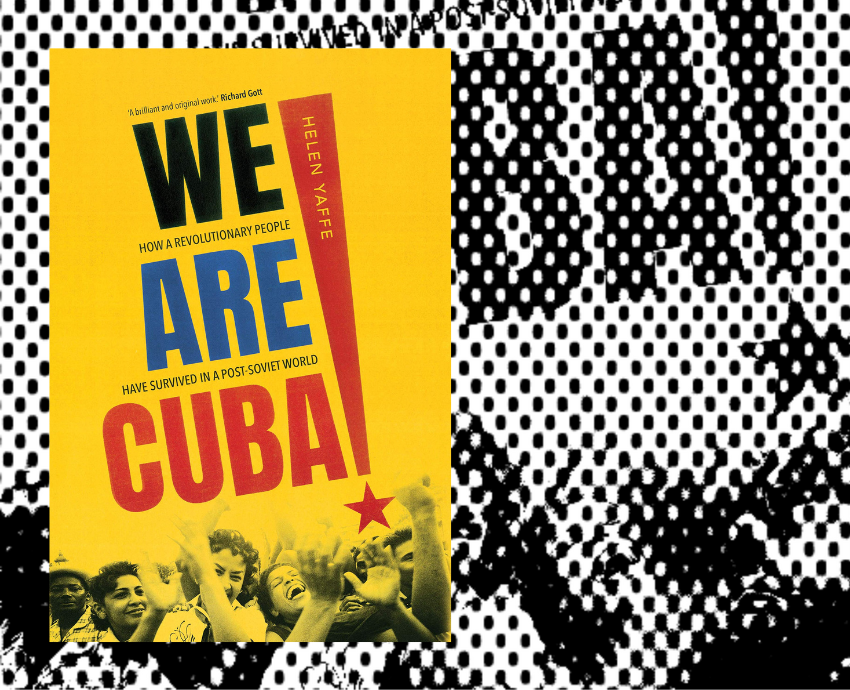
We are Cuba!
How a Revolutionary People Have Survived in a Post-Soviet World
By Helen Yaffe
Yale University Press, 2020
If there is one theme to Helen Yaffe’s book, it is survival. The most remarkable thing about Cuba is that it has survived despite the odds.
First, Cuba survived Spanish rule, even though Spanish colonial imperialism killed off Cuba’s Indigenous population and created a society deeply divided according to class, race and ethnicity.
Cuban patriots fought for independence for more than 30 years. Washington got involved, but only with an eye to moving in as soon as Spain left.
From 1899 to the end of 1958, Cuba was a de facto United States protectorate. By 1950, US companies controlled 90% of Cuba’s electricity and telephone services, 70% of Cuba’s arable land, two-thirds of Cuba’s sugar production and 50% of Cuba’s railways. Only 3% of Cuban farmers owned the land they worked.
When true independence came on January 1, 1959, thanks to the Cuban Revolution, a new era began, but things soon turned ugly. In 1960, US President Dwight D Eisenhower cancelled Cuba’s sugar quota, blocked all US exports to Cuba, other than food and medicines and pressured Latin American countries to cut ties with the island nation.
US President John F Kennedy authorised the Bay of Pigs invasion, banned US citizens from visiting Cuba without a special licence and broke off diplomatic relations, in 1961. The following year, he formalised a blockade of Cuba, banning all US trade and financial transactions other than pursuant to a special licence.
This was the start of the world’s longest economic, financial and commercial blockade — which continues to the present day, made much worse over the years by further draconian US legislation and decrees. The point has now been reached that most of the world’s banks and other financial institutions no longer facilitate transactions involving Cuba for fear of US reprisals.
Cuba survived.
Looking for new trading partners for its primary products, Cuba turned to the USSR. For the next 30 years, Cuba’s main trading partner and benefactor was the Soviet Union. Then came the collapse of the Soviet Union in 1991. The Council for Mutual Economic Assistance (COMECON), which had provided crucial economic assistance and preferential trade agreements to smaller Communist states including Cuba, was dismantled.
Cuba was thrown into economic turmoil, entering what is known as the “special period” — a euphemism for years of financial hardship and massive shortages of food and other essential products. Worse, Washington imposed further draconian sanctions on Cuba in the belief that the end of socialist rule in Cuba was near.
Some $8 billion a year disappeared from Cuban trade. Imports and exports were reduced by more than four-fifths. Cuba’s gross domestic product plunged by 35%. Its agricultural output fell by 47%. Construction fell by 74% and the country’s manufacturing capacity by 90%. There were lengthy blackouts and long food queues.
Cuba survived.
We are Cuba! starts with the “special period” following the Soviet Union’s collapse.
Cuba was isolated and increasingly besieged by Washington.
Cuba ruled out capitalism but the Cuban government opted to preserve, protect and enhance los logros (the achievements) of the revolution. Thus, the aim was to increase productivity and efficiency within an overall socialist framework. Cuba has remained socialist, while allowing free enterprise in certain areas.
Dr Helen Yaffe, who is senior lecturer in economic and social history at the University of Glasgow, draws on archival research and interviews with Cuban leaders, thinkers and activists. She documents the market reforms initiated by the Cuban government and other important initiatives such as the creation of one of the world’s leading biotechnological industries.
Yaffe describes the changes brought by the Cuban government to health care. Under US domination, prior to 1959, 14% of Cubans had tuberculosis. Some 13% had typhoid. Rural areas were inundated with cholera, malaria, parasites and other diseases. Infant mortality was 60 per 1000. Some 91% of Cubans were malnourished. The average life expectancy was 59 years. Vaccination programs were unavailable. Only 10% of children were covered by specialised paediatric care. The pharmaceutical industry was 70% foreign-controlled (mainly American), creating many products lacking therapeutic value.
Today, as a result of several decades of health initiatives by the Cuban government, Cuba has a high life expectancy (marginally higher than that of the United States) and a low infant mortality rate (lower than that of the United States).
Cuba’s Finlay Vaccine Institute is a world leader in biotechnology. Some 80% of all of Cuba's vaccines are produced locally. Past vaccination campaigns have largely eradicated diseases such as measles, rubella, mumps, polio and typhoid. Five Covid-19 vaccines have been produced in recent times, with Cuba being one of the first countries to vaccinate its entire population. Cuba offers its vaccine technology and vaccines to the world, especially to countries deliberately isolated and neglected by Washington.
Yaffe documents Cuba’s achievements in medical internationalism. The Henry Reeve Brigade is regularly deployed worldwide in major health crises.
Yaffe also documents at length Cuba’s energy revolution. The collapse of the Soviet Union resulted in extensive rolling power cuts nationwide. The Cuban government took the opportunity to promulgate and implement environmental policies and practices to achieve sustainable outcomes.
Cuba’s Revolución Energética (Energy Revolution) sought to remedy the initial power crisis as quickly as possible and then replace the obsolete and highly centralised power stations and ageing electricity grid with a more robust, decentralised and ecologically sustainable power system. That was achieved.
Then there are Cuba’s agricultural reforms. The nation’s domestic production of vegetables rose from 4000 tonnes to more than 4 million tonnes between 1994 and 2005. In 2002, Cuba became the only nation achieving sustainable development.
The Cuban revolution has endured. It has survived.
Yaffe’s book is a must-read for all those who have an interest in Cuba and the survival of socialism.